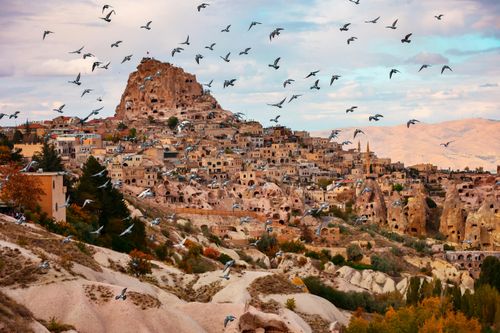A Journey into the Winemaking Tradition of Basilicata
Hidden among the Lucanian hills, on the outskirts of Pietragalla—a small town in the province of Potenza—lies a place of timeless charm: the Palmenti Park. Here, around sixty semi-hypogean structures, carved into the rock and topped with grassy mounds, tell an ancient story of rural ingenuity and passion for wine.
These buildings, resembling small rounded houses, evoke fairytale-like scenery and transport visitors to an era when winemaking was a collective ritual. Today, the Palmenti of Pietragalla stand as a remarkable testimony to Lucanian rural architecture and the deep connection between people and their land.
What Are the Palmenti, and Where Does the Name Come From?
The term "palmenti" appears to derive from the Latin paumentum, itself related to the verb pavire, meaning to press or to tread with feet. This etymology refers to the fundamental gesture of ancient winemaking: the stomping of grapes by foot, a practice that shaped rural life for centuries.
Built from the early 19th century onwards, the Palmenti of Pietragalla were used for grape pressing and must fermentation, before the wine was transferred into underground cellars known as "rutt".
A Functional and Ingenious Architecture
The design of the palmenti was carefully crafted to optimize the winemaking process. Constructed with the local yellowish sandstone, they featured several unique characteristics:
- Three interconnected vats:
- Crushing vat – Where the grapes were stomped to release their juice.
- Fermentation vat – Where the must was left to begin its transformation into wine.
- Collection vat – Where the filtered wine was gathered for transport.
- Thick walls and semi-underground positioning: These ensured a stable temperature, ideal for fermentation.
- Strategic openings on the facade: These promoted ventilation and prevented moisture buildup.
After fermentation, the wine was transported in wooden barrels, carried by mules or donkeys, and brought to the "rutt"—hypogean cellars located in the northwestern part of the town—where it was transferred into casks for aging.
The Decline and Revival of the Palmenti
With the rise of modern winemaking techniques, the use of the palmenti gradually declined. Since the late 1960s, they were largely abandoned, with only one remaining operation preserving this ancient tradition.
Today, the Palmenti Park of Pietragalla has found new life as a cultural and tourist destination, attracting visitors drawn to the history and beauty of these ancient structures.
A Recognized and Celebrated Site
The historical and cultural importance of this site has not gone unnoticed. The FAI – Italian National Trust has recognized the Palmenti of Pietragalla as one of its “Places of the Heart”, emphasizing the value of this unique heritage.
More than just an architectural treasure, the park represents a genuine fragment of rural life—a place where time seems to stand still. Visiting it offers a journey suspended between past and present, revealing one of the most captivating legacies of Lucanian winemaking tradition.
